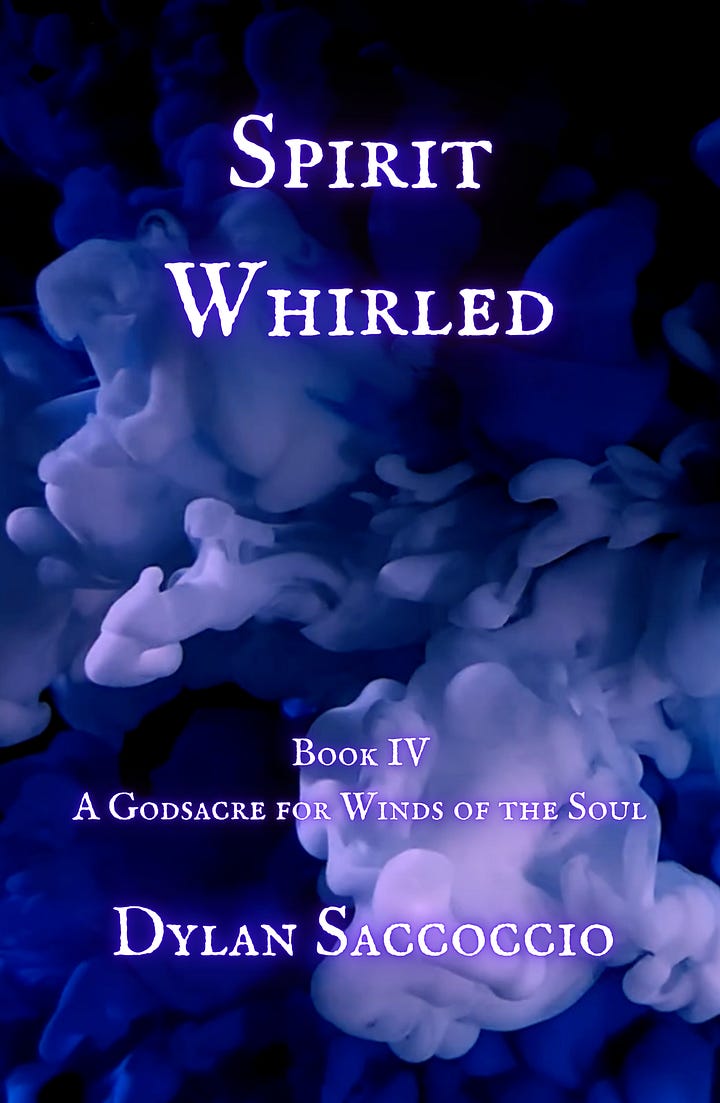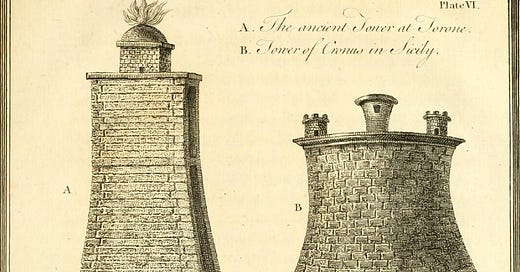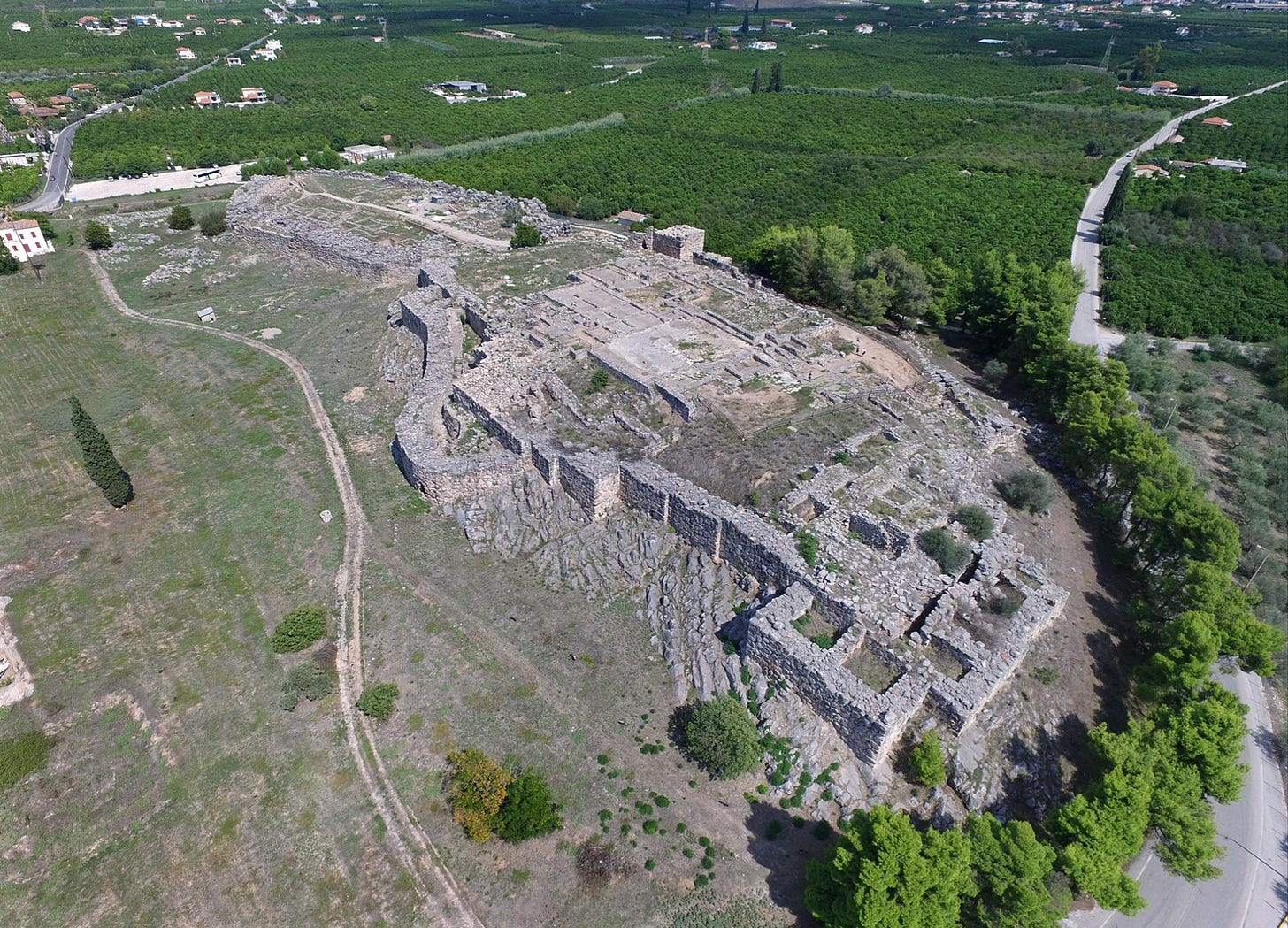Fresh Batch #192: Etruscan Sea-Trumpets, Their Invention of Megalithic Polygonal Cyclopean Masonry, Sea-Towers, & Genetic Match to the Cornish
Amonian radicals Tar, Tor, Tarit, & the Tri-Father Symbolism of Orion & Cerberus
Reminders:
If you are a new subscriber, make sure to add the email address, which sends you these posts, into your contacts. Otherwise, they will not make it to your inbox after a few posts.
All articles can be listened to through the Substack app for those who don’t prefer to read.
The following is an important detail because there is no concrete evidence on why the Etruscans were called Tyrrhenians and Tyrsenians, in addition to also being called Pelasgians, by the Greeks (during the time when it would have been relevant). Dionysius of Halicarnassus allegedly lived most of his life in the 1st century BC, which, according to the status quo, is centuries after the Etruscan Empire. However, if I am correct that the Etruscan Empire was essentially what we call the Roman Empire around the turn of the millennia, then the credibility of DH’s claims may be amplified, given that there is evidence in the archaeological record that Rome was quasi-Etruscan all the way up to the 1st century BC, and artifacts with Etruscan writing were still being created in that region. According to Wiki, Aulus Metellus was an Etruscan senator in the Roman republic, originally from Perugia or Cortona. The Aulus Metellus sculpture was found in 1566 with the exact location being debated. (I will also remind people that, while I acknowledge the advancements of archaeology being the reason so many new discoveries were made, there must also remain the suspicion of forgery. I can tell by the use of certain letters that the inscription is Umbrian, i.e., the letter that looks like 8 signifies F, or Ph.)

According to DH, the Etruscans were named Tyrrhenians and Tyrsenians after towers. He wrote, “As regards these Tyrrhenians, some declare them to be natives of Italy, but others call them foreigners. Those who make them a native race say that their name was given them from the forts, which they were the first of the inhabitants of this country to build; for covered buildings enclosed by walls are called by the Tyrrhenians as well as by the Greeks tyrseis or towers. So they will have it that they received their name from this circumstance in like manner as did the Mossynoeci in Asia; for these also live in high wooden palisades resembling towers, which they call mossynes.”
Jacob Bryant believed the towers that served multiple purposes, for navigators and the like, were made by a race of people called the Amonians. He derives the roots of words in most western languages from their radicals, and thus named them Amonian radicals. However, I suspect many of the these ideas, when accurate, originated from the cultures in Italy. They were primarily of a Celtic, or Central European, phenotype. Their navigators brought it to the regions of the eastern Mediterranean, western Asia, and North Africa. I do not think a race of shepherds, whose history is primarily dependent on the Bible, which has no evidence of being produced during the eras it is claimed to account for. Nonetheless, the towers Bryant attributes to the Amonians may actually be a product of the Etruscans.
Bryant wrote (Analysis. Anc. Myth. pp. 399-400.), “They built upon every hill, and promontory, where they had either commerce or settlement, obelisks, and towers, which they consecrated to some Deity. These served in a twofold capacity, both as seamarks by day, and for beacons by night. And as people in those times made only coasting voyages, they continually went on shore with offerings, in order to gain the assistance of the God, whoever there presided: for these towers were temples, and oftentimes richly furnished and endowed. They were built sometimes on artificial mounds; but generally on natural eminences, that they might be seen at a great distance. They were called by the Amonians, who first erected them, Tar, and Tor (Bochart Geog. Sacra. L. 1. c. 228. p. 524. of תור [TUR; TYR]); the same as the תור (TUR, TYR) of the Chaldees, which signified both a hill and tower.”
Again, this is problematic because the Chaldean alphabet, which is claimed to beget the Hebrew one, comes from Phoenician, which is claimed to come from Pelasgian, and the Etruscans were called Pelasgians, as well as Tyrrhenians and Tyrsenians, by the Greeks. This is why certain Phoenician words, such as Amon, can be purely read in Etruscan as OMN: 𐤏𐤌𐤍. Also, recall that Tyre, the alleged capital of Phoenicia, is written 𐤑𐤓 (Tsr), pronounced Sur.
Bryant continued (Ib. p. 400.), “They were oftentimes compounded, and styled Tor-Is, or fire towers: on account of the light, which they exhibited, and the fires, which were preserved in them. Here came the turris of the Romans; and the τυρις, τυρρις, τυρσις, τυρσος, of the Greeks. The latter, when the word Tor occurred in ancient history, often changed it to ταυρος (tauros), a bull; and invented a number of idle stories in consequence of this change.”
I’m not sure where this fits in, but in some locations, the only certain remains of the Etruscan cities or habitations are their walls, mythologized and referred to as Cyclopean (by the Greeks).
Theodor Mommsen wrote (Hist. Rome. Vol. 1. p. 235.), “What are called Cyclopean ring-walls frequently occur in Italy, especially in Etruria, Umbria, Latium, and Sabina, and decidedly belong in point of design to the most ancient buildings of Italy.”
Again (Ib. p. 236.), “—the true polygonal masonry is found in Etruria only at Pyrgi and at the towns, not very far distant from it, of Cosa and Saturnia; and as the design of the walls of Pyrgi, especially when we take into account the significant name (‘towers’)—”
He neglects to mention the Etruscan or Latin word for towers, but he suspected the Etruscans learned this type of architecture from Tiryns in Argolis, spelled Τίρυνς in so-called Ancient Greek. However, Tiryns has the same phonetic root as the subject at hand.
Citadel of Tiryns
If the chronological and historical records were accurate, this would be a reasonable conclusion. However, it has been demonstrated that by various writers, whether intentionally or not, that the chronological and historical records are not accurate.
Bryant continued (Ib. p. 400.), “The Ophite God Osiris, the same as Apollo, was by the Amonians styled Oph-El, and Ope-El (no inscriptions were provided): and there was upon the Sinus Persicus a city Opis, where his rites were observed. There seems likewise to have been a temple sacred to him, named Tor-Opel; which the Greeks rendered Ταυροπολος (Tauropolos). Strabo speaks of such an oracular temple; and says, that it was in the island Icaria towards the mouth of the Tigris: Νησον Ικαριον, και ίερον Απολλοωνος άγιον εν αυτη, και μαντειον Ταυροπολου. (There was a sanctuary of Apollo with a temple and oracle of Tauropolis in it, on the island of Icharia. Strabo. L. 16. p. 1110.) Here, instead of Osiris, or Mithras, the serpent Deity, the author presents us with Apollo, the manger of bulls.
Bryant continued (Ib. pp. 401-2.), “Colchis was styled Cutaia, and had been early occupied by the sons of Chus. (I do not accept this as true, but I’m including it to show how Bryant suggested the misinterpretation of this word led to a fable.) The chief city, whence the country has been in general denominated, was from its situation called Cal-Chus, and Col-Chus, the hill, or place of Chus. This by the Greeks was rendered Colchis: but as travellers are not uniform in expressing foreign terms, some have rendered, what was Colchian, and Chalcian, and from Colchus they have formed Χαλκος (Chalkos), brass. The Chalcian towers being moreover interpreted ταυροι, bulls, a story took its rise about the brazen bulls of Colchis. Besides this there was in these towers a constant fire kept up for the direction of ships by night: whence the bulls were said to breath fire.”
Revisit this Inner Whirled episode regarding this subject.
Inner Whirled | Episode 3
My friend Chance Garton and I will be diving into some subjects from time to time that will only be available to those of you who support us. Thank you for contributing to our work and enjoy this episode!
As a brief aside, there may be a philological interchange between N and R regarding Tarit and Tanit, as ben and bar both signify son in Hebrew and are written BN (בן) and BR (בר) respectively. So it may behoove you to revisit Fresh Batch #136 and recall the significance of Tanit to the Etrusco-Phoenician mariners before continuing.
Fresh Batch #136: Our Lady of Sicily & Carthage
Sicily is probably the most important location as a hub for the ancient maritime empire. It is situated where the Tyrrhenian, Ionian, and Mediterranean Seas merge. By the time you finish this article, you’ll have a better understanding of why so many powerful people lived there.
To learn more about the ancient universal system and its implications on the historical and chronological records, which are contrary to what modern academia teaches, invest in the Spirit Whirled series and The Real Universal Empire.







Become a member to access the rest of this article.
Keep reading with a 7-day free trial
Subscribe to Ancient History, Mythology, & Epic Fantasy to keep reading this post and get 7 days of free access to the full post archives.











